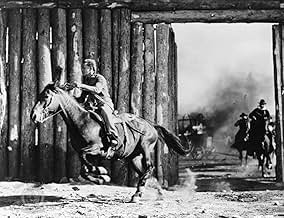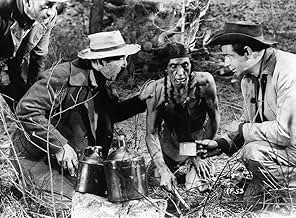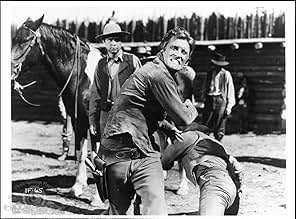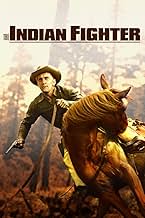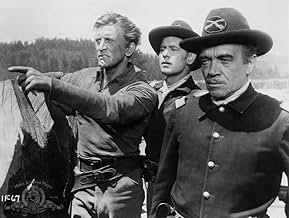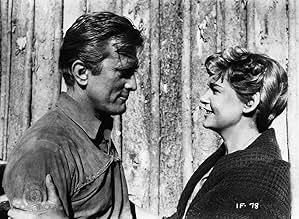NOTE IMDb
6,3/10
3,1 k
MA NOTE
Un éclaireur menant un convoi en territoire indien hostile s'implique involontairement avec la fille d'un chef sioux.Un éclaireur menant un convoi en territoire indien hostile s'implique involontairement avec la fille d'un chef sioux.Un éclaireur menant un convoi en territoire indien hostile s'implique involontairement avec la fille d'un chef sioux.
- Réalisation
- Scénario
- Casting principal
Lon Chaney Jr.
- Chivington
- (as Lon Chaney)
Alan Hale Jr.
- Will Crabtree
- (as Alan Hale)
Elisha Cook Jr.
- Briggs
- (as Elisha Cook)
Lane Chandler
- Head Settler
- (non crédité)
Robert 'Buzz' Henry
- Lt. Shaeffer
- (non crédité)
Avis à la une
It's called The Indian Fighter but oddly, in Andre de Toth's post Civil War western, Kirk Douglas playing Indian scout, Johnny Hawks, is the paleface who has the closest relationship with the local Sioux tribe and its leader Red Cloud. And while there appear to be quite a few native Americans doing their bit as tribal extras, the 4 main Indian roles are taken by 3 white guys and an Italian girl. To be fair I guess, it needs to be pointed out that the film is 66 years old, when prominent Native American actors weren't exactly a dime a dozen roaming Hollywood streets.
And Hollywood streets and backlots is not where The Indian Fighter was filmed. It's setting is Oregan and the movie makes particularly good use of the ruggedly scenic locations on tap and wisely even takes some time out for some diverting philosophic conversations, about the possibilities and long - term ramifications of a shrinking frontier.
Douglas's Hawks is not even your conventional western hero. He takes on more of an anti - hero status, with much of the dramatic content occurring as a direct result of him taking his eye off the ball for long periods, whilst being distracted by the charms of Red Cloud's daughter, Ohanti. Elsa Martinelli as Onahti is almost believable in the role, if you ignore her pronounced Italian accent. Anachronistically, she is also asked to act out one of those "Stop! Stop! I love it" routines which periodically reared their heads in 20th century movie - making, where the poor old, put upon female, is asked to put aside bullying, sexist male behaviour, in demonstrating she was actually receptive to it.
The narrative, whether deliberate or otherwise, ends up quite morally correctly, in the corner of the Indians. But everything is rather awkwardly put together. This includes the 2 cheesily, funny aquatic, nude scenes; one to introduce the character of Ohanti and the second to quite ludicrously finish, the film on an almost farcical note, with Hawks and Ohanti romping in the rapids together.
The Indian Fighter will be remembered as an entertaining vehicle for a somewhat over-acting Kirk Douglas, whilst attempting to portray Native Americans in a more positive light, but through a distinctly patronising means.
And Hollywood streets and backlots is not where The Indian Fighter was filmed. It's setting is Oregan and the movie makes particularly good use of the ruggedly scenic locations on tap and wisely even takes some time out for some diverting philosophic conversations, about the possibilities and long - term ramifications of a shrinking frontier.
Douglas's Hawks is not even your conventional western hero. He takes on more of an anti - hero status, with much of the dramatic content occurring as a direct result of him taking his eye off the ball for long periods, whilst being distracted by the charms of Red Cloud's daughter, Ohanti. Elsa Martinelli as Onahti is almost believable in the role, if you ignore her pronounced Italian accent. Anachronistically, she is also asked to act out one of those "Stop! Stop! I love it" routines which periodically reared their heads in 20th century movie - making, where the poor old, put upon female, is asked to put aside bullying, sexist male behaviour, in demonstrating she was actually receptive to it.
The narrative, whether deliberate or otherwise, ends up quite morally correctly, in the corner of the Indians. But everything is rather awkwardly put together. This includes the 2 cheesily, funny aquatic, nude scenes; one to introduce the character of Ohanti and the second to quite ludicrously finish, the film on an almost farcical note, with Hawks and Ohanti romping in the rapids together.
The Indian Fighter will be remembered as an entertaining vehicle for a somewhat over-acting Kirk Douglas, whilst attempting to portray Native Americans in a more positive light, but through a distinctly patronising means.
Kirk Douglas is portrayed as a lovable jack-the-lad here, always ready to fight for right. He's got a winning quip, a twinkle in his eye and a heart of a lion. I beg to differ.
For starters, right at the beginning he sees an Indian squaw he likes, taking a bath in a lake. So what does he do? Forget about roses or chocolates... he virtually ASSAULTS her to get a kiss, and then steals her knife into the bargain. Later on, he does the exact same thing. Guess what... this brutish behaviour actually makes her FALL IN LOVE with the maniac, and she has sex with him in the forest (only implied though... this WAS made in 1955 after all). This infatuation also causes him to divert a wagon train of white folk on a two day detour from their destination into hostile Indian territory... just so he can sneak a peek at her. This leads to a huge fight, in which many lives are lost on both sides. Some 'hero'.
If you ignore the movie's celebration of this psycho, and the dubious underlying message that we should all resort to Stone Age methods to get the girl of our dreams, there is quite a bit to enjoy here. Full scale battles, majestic cinematography, a compelling story, the works. There are amusing supporting characters, including a young guy who wants to photograph the whole Wild West with his newfangled invention known as a 'camera', and a tough widow with a little boy who is constantly proposed to by a boring fertiliser-obsessed farmer. Sadly for him, her affections (which remain unrequited) lie with Kirk Douglas... and even more bafflingly, her son idolises this lunatic too. Suddenly, soil is starting to seem more appealing by the minute...
So, yeah. Not a classic, but a rousing enough spectacle. With a protagonist I love to hate. Next... 6/10
For starters, right at the beginning he sees an Indian squaw he likes, taking a bath in a lake. So what does he do? Forget about roses or chocolates... he virtually ASSAULTS her to get a kiss, and then steals her knife into the bargain. Later on, he does the exact same thing. Guess what... this brutish behaviour actually makes her FALL IN LOVE with the maniac, and she has sex with him in the forest (only implied though... this WAS made in 1955 after all). This infatuation also causes him to divert a wagon train of white folk on a two day detour from their destination into hostile Indian territory... just so he can sneak a peek at her. This leads to a huge fight, in which many lives are lost on both sides. Some 'hero'.
If you ignore the movie's celebration of this psycho, and the dubious underlying message that we should all resort to Stone Age methods to get the girl of our dreams, there is quite a bit to enjoy here. Full scale battles, majestic cinematography, a compelling story, the works. There are amusing supporting characters, including a young guy who wants to photograph the whole Wild West with his newfangled invention known as a 'camera', and a tough widow with a little boy who is constantly proposed to by a boring fertiliser-obsessed farmer. Sadly for him, her affections (which remain unrequited) lie with Kirk Douglas... and even more bafflingly, her son idolises this lunatic too. Suddenly, soil is starting to seem more appealing by the minute...
So, yeah. Not a classic, but a rousing enough spectacle. With a protagonist I love to hate. Next... 6/10
I had noticed this video for rent several times, but had always thought that the cover photo showed Kirk Douglas with Natalie Wood. Much to my surprise, it turns out not to be Natalie at all, but someone far more unusual, Elsa Martinelli, someone it seems I know best as Charlton Heston's love interest in "The Pigeon That Took Rome", the slim but pleasant comedy from 1962.
In fact, this film is "introducing Elsa Martinelli", a fresh import from Italy at the time. Bell' Italia indeed. Elsa introduces herself to us in the opening scene by undressing completely to go for a quiet dip in the river. So it's going to be la dolce vita along the riverbank, it seems...
As the beautiful long-haired Indian maiden, Elsa finds herself teamed with Kirk, brandishing his chin and his triangular physique. The Wild West lives up to its name, not only with the Indians' fiery attack on the army fort, the film's climax, but also with the steamy roll in the "surf" by our two principals, a couple of years after "From Here to Eternity".
The film offers Elisha Cook an unusual part to play, a photographer who had worked with Matthew Brady during the War, and who now wants to immortalize the West with his camera as advertising to attract settlers. The film understands the dichotomy of preservation and destruction that his character represents.
Walter Matthau and Lon Chaney are the bad white men, while Alan Hale (Gilligan's Skipper) and Frank Cady (Green Acres' Mr. Drucker) round out a nostalgic supporting cast.
Produced by Kirk Douglas's own production company, Bryna, "The Indian Fighter" can't help but have a social conscience. It does show the strong influence of the message Western -- in its interracial romance, Cook's proto-Ansel Adams character, and so on -- but without sacrificing the adventure elements of the story.
The film boasts some spectacular Oregon scenery. It's not the Monument Valley desert landscape we're used to seeing in so many other epic Westerns when directed by John Ford, but rather mountainous and riverine terrain, more like what Ford showed us in "How the West Was Won" (1962).
André De Toth provides good solid Cinemascope direction, letting the widescreen process work its own wonders on the audience. The film however does betray more brutality than I would have expected, especially for its day.
All in all, an adventure story intelligently and attractively handled, with some depth for those who care to look.
In fact, this film is "introducing Elsa Martinelli", a fresh import from Italy at the time. Bell' Italia indeed. Elsa introduces herself to us in the opening scene by undressing completely to go for a quiet dip in the river. So it's going to be la dolce vita along the riverbank, it seems...
As the beautiful long-haired Indian maiden, Elsa finds herself teamed with Kirk, brandishing his chin and his triangular physique. The Wild West lives up to its name, not only with the Indians' fiery attack on the army fort, the film's climax, but also with the steamy roll in the "surf" by our two principals, a couple of years after "From Here to Eternity".
The film offers Elisha Cook an unusual part to play, a photographer who had worked with Matthew Brady during the War, and who now wants to immortalize the West with his camera as advertising to attract settlers. The film understands the dichotomy of preservation and destruction that his character represents.
Walter Matthau and Lon Chaney are the bad white men, while Alan Hale (Gilligan's Skipper) and Frank Cady (Green Acres' Mr. Drucker) round out a nostalgic supporting cast.
Produced by Kirk Douglas's own production company, Bryna, "The Indian Fighter" can't help but have a social conscience. It does show the strong influence of the message Western -- in its interracial romance, Cook's proto-Ansel Adams character, and so on -- but without sacrificing the adventure elements of the story.
The film boasts some spectacular Oregon scenery. It's not the Monument Valley desert landscape we're used to seeing in so many other epic Westerns when directed by John Ford, but rather mountainous and riverine terrain, more like what Ford showed us in "How the West Was Won" (1962).
André De Toth provides good solid Cinemascope direction, letting the widescreen process work its own wonders on the audience. The film however does betray more brutality than I would have expected, especially for its day.
All in all, an adventure story intelligently and attractively handled, with some depth for those who care to look.
This isn't terrible as far as a typical old western. Kirk Douglas does a great job including with his stunts. What I found rather unsettling were the several scenes where he forced himself on a woman both for kissing and sex. Rather than portray it with the disdain it should have, it's presented as a happy time which turns my stomach.
I remember having enjoyed very much this film as a kid back in the 50's, but not when I saw it again a couple of years ago. The story is not better or worst than that of many other westerns -a scout leads a wagon train through hostile Indian territory- but Andre de Toth's direction is weak and completely standard; these are things you don't notice in films as a kid when you're more interested in cowboys and Indians fights and action scenes. In my opinion, De Toth was just an average director that will probably be remembered for his earlier work in "House of Wax" (1953) when aided by an interesting plot and an excellent Vincent Price he achieved a little classic in the horror genre; but he never reached the mark later.
As for "The Indian Fighter", you can rescue Kirk Douglas undeniable strong screen presence, one of Walter Mattau's early roles as a villain and the sensual Italian actress Elsa Martinelli as an Indian squaw that gets mixed up with Douglas.
But there's not much more in this average and common film, only for fans of the genre or good old Kirk (in his late thirties back then).
Just for the record: in Argentina "The Indian Fighter" was renamed as "A un Paso de la Muerte" (something like "Just One Step Away from Death").
As for "The Indian Fighter", you can rescue Kirk Douglas undeniable strong screen presence, one of Walter Mattau's early roles as a villain and the sensual Italian actress Elsa Martinelli as an Indian squaw that gets mixed up with Douglas.
But there's not much more in this average and common film, only for fans of the genre or good old Kirk (in his late thirties back then).
Just for the record: in Argentina "The Indian Fighter" was renamed as "A un Paso de la Muerte" (something like "Just One Step Away from Death").
Le saviez-vous
- AnecdotesKirk Douglas did most of his own horseback riding and, at one point, broke his nose attempting a stunt that called for him to make his horse fall. Instead of leaning back in the saddle when yanking the horse's head around to the side, Douglas leaned forward and took the full force of the horse's heavy head right in the face. Bill Williams was Douglas' stunt double, and "was an excellent rider [he was later killed doing a stunt for Sur la piste de la grande caravane (1965)], and in silhouette looked a lot like me."
- GaffesRight before the Indians tie Todd to the tree with the intention of burning him, he's having a conversation with Johnny. During this conversation, Johnny's left arm repeatedly changes positions, from being stretched out against the tree, to holding his hat in front of him and back to stretched out against the tree.
- Citations
Grey Wolf: There can be no friendship between Red Man and White. The fight is to the end. Ride back to your people. There is no room for you here.
Johnny Hawks: You've grown a big mouth since I saw you last, Grey Wolf, but I didn't come here to talk to a big mouth. I've come to talk to a big man.
- ConnexionsReferenced in Le pigeon (1958)
Meilleurs choix
Connectez-vous pour évaluer et suivre la liste de favoris afin de recevoir des recommandations personnalisées
- How long is The Indian Fighter?Alimenté par Alexa
Détails
Box-office
- Montant brut aux États-Unis et au Canada
- 2 450 000 $US
- Durée
- 1h 28min(88 min)
- Rapport de forme
- 2.35 : 1
Contribuer à cette page
Suggérer une modification ou ajouter du contenu manquant


